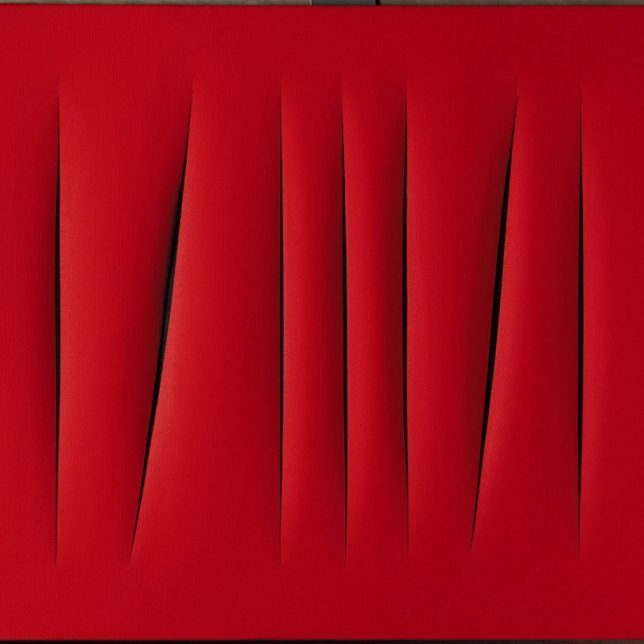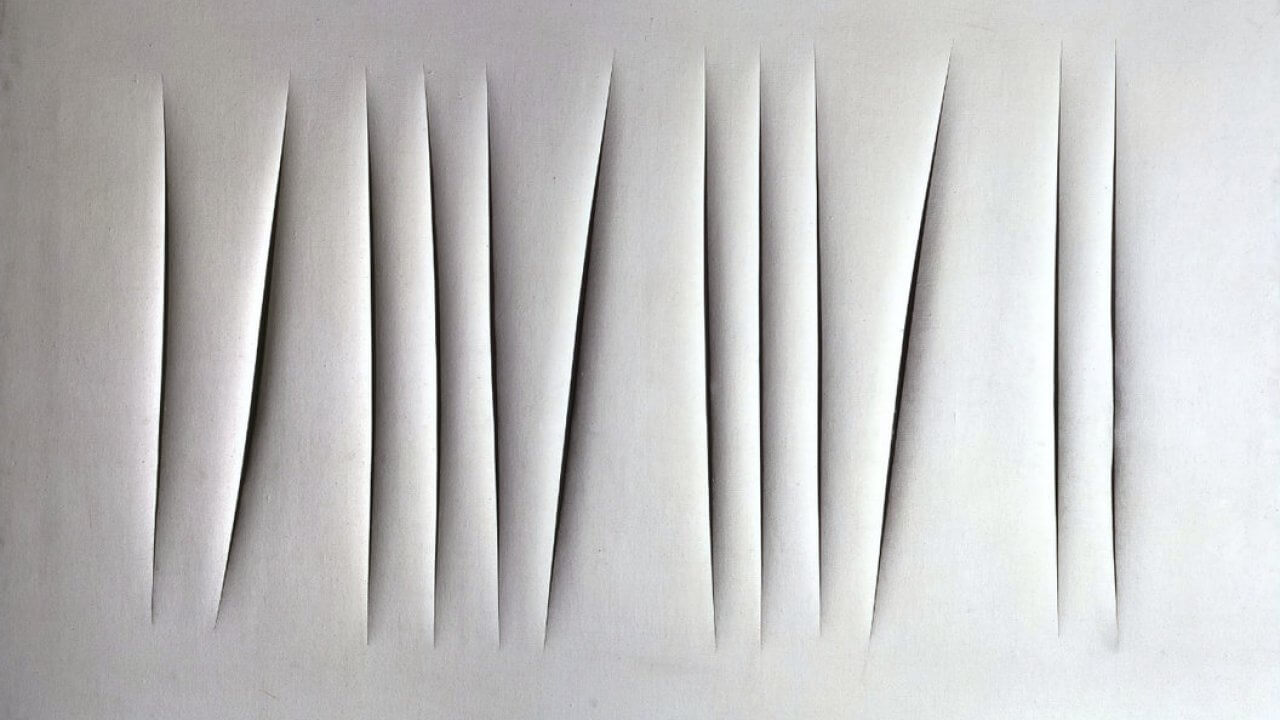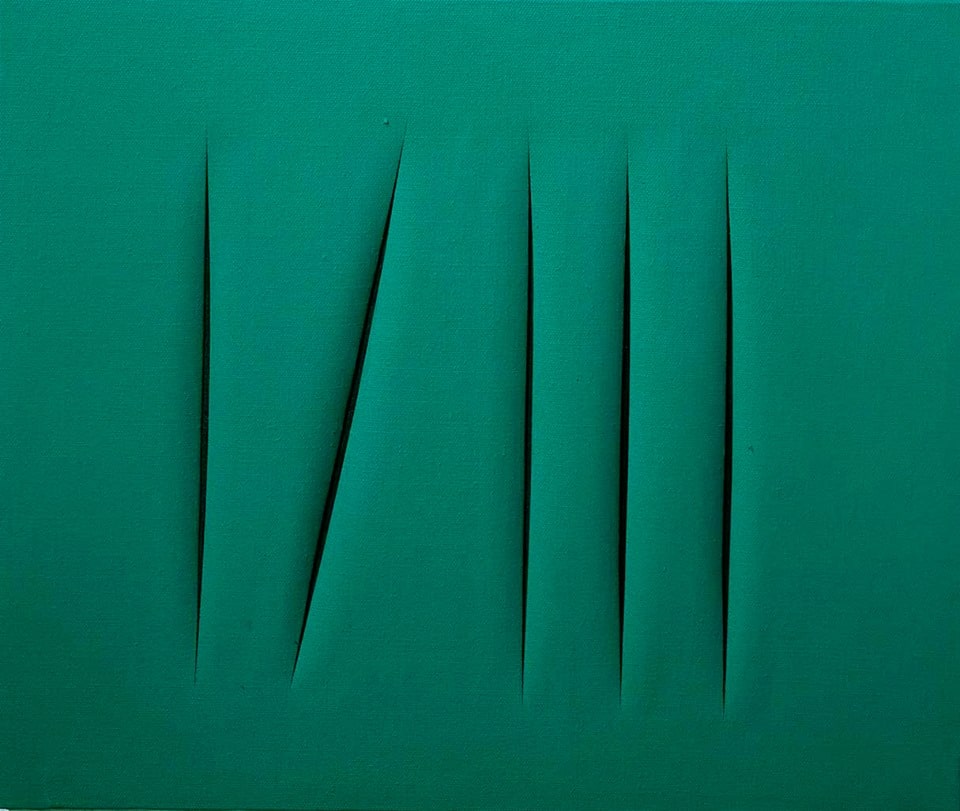
Lucio Fontana, A Visionary Artist

You may not be familiar with his name, but chances are you have already seen his signature monochromatic slashed paintings. Father of the “Spatialism” movement, Lucio Fontana’s innovative genius was crucial to the development of abstract art. From January to April 2019, the MET New York dedicated an exceptional retrospective to the Italian artist, “Lucio Fontana: On the Threshold“, and showcased some of his most famous works. In this article, we focus on the life and work of a visionary artist who inspired many artistic movements of the 20th century.
A pioneering artist

Lucio Fontana was born in 1899 in Rosario de Santa Fé, Argentina to Italian parents. He spent the 1930s and 1940s in Italy and France, where he worked as a sculptor and organised his first exhibitions. Although he is mostly known for his painting series, Fontana trained initially as a sculptor. His background and education in sculpture explains his relentless interest in the relationship between surface and dimensionality. Around this time, he started experimenting with works like Scultura Spaziale, already touching upon the notion of Spatialism.
With the outbreak of the Second World War, Fontana sought refuge in his native country of Argentina, where he founded the Altamira Academy and wrote the Manifesto Blanco with his students and laid down the theories and ideas which came to shape the Spatialism movement. By formulating his ideas on artistic research, he defined a new kind of art and rejected old traditions.
After WWII, Fontana came back to Italy where he continued to explore the ideas behind the Spatialism art movement. He started experimenting with the most innovative mediums, especially light and void as a way to generate space. The Italian artist was acclaimed by art critics for his inventiveness during his lifetime, and died in 1968 in Comabbio, Italy.
A revolutionary artistic movement

The main idea behind Spatialism was to create a form of art that would make synthesis of sound, colour, movement and space in one single artwork. As he explained in Manifesto Blanco, his ultimate desire was to create a unity of art and space: “Colour, an element of space; sound, an element of time; and movement, unfolding in space and time.” Fontana also found inspiration in the Futurists’ fascination with technology. He wanted to encourage artists to embrace modernity and use new techniques suitable for a modern age.
Fontana was obsessed with the conceptual dimension of the art and perceived it as an instrument for research, rather than a mere matter of aesthetic. As he put it, “I do not want to make a painting; I want to open up space, create a new dimension, tie in the cosmos, as it endlessly expands beyond the confining plane of the picture.”
These innovations opened up new perspectives for artistic research, foreshadowing major artistic movements of the 20th century such as Arte Povera, Abstract Expressionism, Minimalism, and Zero.
Focus on selected works
1. Concetto Spaziale

The Concetto Spaziale, later subtitled “Attese,” (the wait) is his most famous series. The meticulous slashed monochromatic canvases initiated the “tagli” cycle, breaking with the “informal” and random gesture of his previous “buchi” phase. By perforating and lacerating his canvases, Fontana goes beyond the materiality of the canvas. They are no longer a flat surfaces but become a three-dimensional object. The painting itself becomes obsolete, making the creation of artworks no longer additive, but rather subtractive.
Fontana uses the cuts to suggest an idea of emptiness, opening space and the void for a concrete experience of space. The radical gesture indicates a rupture with academic tradition of painting; the holy canvas is, so to speak, violated. Fontana reveals the materiality of the support itself, and breaks with the illusionist tradition associated with painting. This way, he denounces the bourgeoise connotation of the decorative and aesthetic function of the Art. Illusion is replaced with the experience; shadows are no longer simulated by mimesis, but genuinely appears on the canvas.
2. Ambiante Spaziale a Luce Nera

Fontana’s work goes way beyond inflicting holes and cuts to his canvases. His work Ambiante Spaziale a Luce Nera, created in 1949, is a pioneering example of what later became known as installation art. 70 years later, it still has a contemporary feel to it. For this work, Fontana used innovative materials such as neon and phosphorescent paint. The installations would last six days only, just the time of the exhibition. Fontana wanted to create a space of “emotive liberty” for the visitor, with “neither painting, nor light; a luminous form in space”. They are Fontana’s most experimental yet least-known works, due to their ephemeral nature.

About Artsper
Founded in 2013, Artsper is an online marketplace for contemporary art. Partnering with 1,800 professional art galleries around the world, it makes discovering and acquiring art accessible to all.
Learn more













